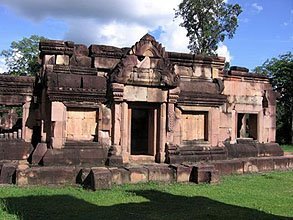Thom (big) problems at Ta Muen
It had to happen eventually. I see the news media are now linking the little-known Ta Muen Thom temple to the stand-off at Preah Vihear, 130kms to the east of the smaller site. Reports of Thai troop movements at Ta Muen have made the press though in reality, the temple has been 'occupied' by Thailand for a few years now and that shows no sign of abating. It's small fry compared to Preah Vihear but it's a subject that still rankles with Cambodians whenever its mentioned.
I highlighted the difference of opinion between Cambodia and Thailand over this temple in my blog in December. To refresh memories, here's what I said at the time:
If you're not aware, one of my biggest passions is visiting ancient Khmer temples, dotted around the Cambodian countryside. However, there are a series of Khmer temples in northeast Thailand that I have yet to visit so I was particularly interested in a report from Radio Free Asia's correspondent Kim Pov Sottan which highlighted the issue surrounding the 12th century Angkorean temple of Prasat Ta Muen Thom - which is in fact three ruined structures all with the same generic name - in a location that seems to be on the very border between Cambodia and Thailand. If you speak to the Khmers in the locality, they'll tell you that the temple is Cambodian and that the Thai's have stolen it in the last few years, whilst the Thai's have assumed responsibility for the temple and built a paved road for easy access for visitors. The report from RFA suggested that even the Thai military commander for the area claims that the temple is in a 'white zone' which is technically a disputed, no-man's land.Cambodia has experienced border disputes with Thailand and Vietnam Thailand
Michael Freeman’s excellent Guide to Khmer Temples inThailand and Laos throws a bit more light on the border temples of Prasat Ta Muen Thom, Ta Muen Toch and Ta Muen, after Radio Free Asia reported on the dispute over temple ownership between Cambodia and Thailand Dangrek Mountains , and is unique amongst the sanitized Khmer temples in Thailand Royal Road Angkor to Phimai as it crosses the mountains. Ta Muen Toch is 1.5km and Ta Muen 2kms from the larger temple. Work on restoring the temples began in 1991 by the Thai Fine Arts Department and the trees at the foot of the approach to the larger temple, from the south, is where the existing border has been demarcated.
I highlighted the difference of opinion between Cambodia and Thailand over this temple in my blog in December. To refresh memories, here's what I said at the time:
If you're not aware, one of my biggest passions is visiting ancient Khmer temples, dotted around the Cambodian countryside. However, there are a series of Khmer temples in northeast Thailand that I have yet to visit so I was particularly interested in a report from Radio Free Asia's correspondent Kim Pov Sottan which highlighted the issue surrounding the 12th century Angkorean temple of Prasat Ta Muen Thom - which is in fact three ruined structures all with the same generic name - in a location that seems to be on the very border between Cambodia and Thailand. If you speak to the Khmers in the locality, they'll tell you that the temple is Cambodian and that the Thai's have stolen it in the last few years, whilst the Thai's have assumed responsibility for the temple and built a paved road for easy access for visitors. The report from RFA suggested that even the Thai military commander for the area claims that the temple is in a 'white zone' which is technically a disputed, no-man's land.
Michael Freeman’s excellent Guide to Khmer Temples in



3 Comments:
Andy, great photos as usual. Do you have any idea where these stolen Cambodian artifacts are going? I've been to the markets in Bangkok, but rarely see anything obviously stolen, and most Western museums are on high alert about these stolen images. So where do they go? Have you spoken with anyone about this?
Hi Carl,
The stolen items are usually headed straight for Bangkok and Singapore (because of their liberal laws on these things) I believe, and in the past were 'made to order' by private collectors or people who know what sells best.
I've seen at least 1 documentary that followed (with mini-cam) a well-known expert into the antique markets in Bangkok where he was shown and offered pieces that had obviously been stolen from Khmer temples. That was a while back but I'm sure if you dig deep enough, those shops will still have Khmer items for sale. I'm not aware that the Thai authorities have done much, or anything, to stop the trade in Khmer antiquities.
The people who know considerably more than I are at Heritage Watch.
Dougald O'Reilly leads the HW team and its their goal to preserve the heritage of SEAsian countries, particulatly in Cambodia.
Visit www.heritagewatch.org
Regards, Andy
Andy,
I was at Ta Muen in february of 2008. It was funny as I got there on my bicycle I first came to Ta Muen Thom first. But I thought it was the first ruin, so after I looked at it I walked into Cambodia (unknowingly) as the Blue Guide said the next ruin was 200 meters south. Soon the danger mine signs started to appear and I figuered it out, and went back to Thailand. After visiting Thom I made my way back north and ran into the other two. Here is a link to the journal on the day of my visit to Ta Muen: http://www.crazyguyonabike.com/doc/page/?o=3Tzut&page_id=70547&v=8P
Post a Comment
<< Home